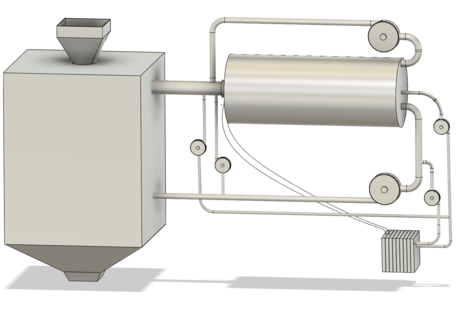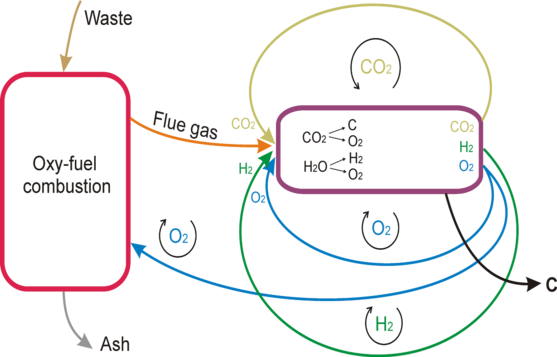The decarbonization of industry is a crucial step in the global fight against climate change. It refers to the reduction of greenhouse gas emissions resulting from industrial processes and activities. Industry is a major source of greenhouse gas emissions, especially carbon dioxide.
By decarbonizing, industry can make a significant contribution to reducing emissions and thus limiting the rise in the global average temperature. The need to reduce CO₂ emissions is driving the development and implementation of innovative technologies and solutions.
VABECK® is developing an affordable and clean technology for industrial decarbonization and climate protection. VABECK® PROCESS uses the physical laws and energy of nature for environmentally friendly energy-intensive industrial processes.
VABECK® PROCESS can be applied in many industrial sectors and can be used for various green and economical industrial processes.
However, incineration produces enormous amounts of carbon dioxide: one tonne of CO₂ is produced for every tonne of waste, and almost three tons if plastics are incinerated.
However, toxic gases such as dioxins, furans and nitrogen oxides are released in exhaust gases, which can pose a threat to human health and the environment.
However, waste incineration plants require considerable investment and can be expensive to operate.
Waste incineration plant without CO₂ emissions and without a chimney?
Unrealistic?
Illusory?
Absolutely not!
VABECK® PROCESS makes this possible!
We have developed a concept for a waste incineration plant that enables very efficient and environmentally friendly waste disposal without causing any CO₂ emissions. We show that this concept is energetically favorable and procedurally feasible from the point of view of the chemical processes and the physical process. The technical innovation consists of a combination of complete waste incineration in pure oxygen (oxyfuel incineration) and the thermal splitting of CO₂ with parallel separation of the reaction products.

Zero-CO₂ waste incineration plant

Waste incineration takes place in a closed cycle, the end products are solid slag and solid carbon, no exhaust gases are emitted into the atmosphere. There is no need for a huge chimney and, in addition to large plants, small but economically effective and environmentally friendly waste incineration plants can also be produced, which can be installed directly where the waste is produced. All processes take place in a cycle until the carbon dioxide is completely decomposed, there are no emissions into the atmosphere, the end products are solid materials and a huge chimney is obsolete.

Circulation
Waste incineration according to VABECK® PROCESS causes no or at least significantly reduced
CO₂ emissions, thus making a major contribution to protecting the environment, climate and resources.
and the impact of CO₂ pricing on waste charges can be avoided.
By using concentrated oxygen, waste can be completely incinerated and the amount of slag to be disposed of can be significantly reduced.
Using the hydrogen produced as an energy source enables more efficient operation of the waste incineration plant. Better combustion in oxygen means that less or no drying of the waste is required.
Waste incineration takes place in a closed cycle, the end products are solid slag, solid carbon and possibly small amounts of hydrogen.
No chimney is required and, in addition to large-scale plants, small but economically effective and environmentally friendly waste incineration plants can also be produced, which can be installed directly where the waste is produced. This can also save costs for waste transportation.
If organic waste is incinerated, the process will actively reduce the total CO₂ content in the atmosphere, as the carbon removed from the air when plants grow is not released back into the atmosphere as carbon dioxide, but can be stored or utilized in the form of solid carbon.
Reducing CO₂ emissions in the cement industry is critical to achieving climate targets and minimizing the environmental impact of this important industry. Today's proposals to reduce the cement industry's carbon footprint mainly involve very expensive and controversial Carbon Capture and Storage (CCS) technology to capture and store CO₂ from emissions. This does not solve the problem, but merely postpones it to the future.
VABECK® PROCESS does it differently, carbon dioxide is converted into solid carbon and stored in an environmentally friendly way or used as a valuable commodity.
After the cement is used for concrete structures and the buildings are constructed, a slow process begins in which CO₂ from the atmosphere is chemically recombined in the concrete. This process is called carbonatation, which means that the VABECK® PROCESS actively reduces CO₂ during cement production, turning concrete from a climate killer into a climate saver.
The production of iron from iron carbonate, also known as siderite, is associated with significant CO₂ emissions, especially when coking coal is used as a reducing agent:
The use of hydrogen as a reducing agent offers some environmental advantages, as no CO₂ is involved in the reduction process.
However, this does not make iron production from iron carbonate without CO₂ emissions, because carbon dioxide is released during the conversion of FeCO₃ to iron oxide. In addition, the procurement of green hydrogen in sufficient quantities and at competitive prices poses a considerable challenge.
The carbon dioxide from iron production is converted into solid coal and at the same time hydrogen is produced for the reduction of iron oxide from water. Another advantage is that the oxygen produced can be used effectively for the heating processes in iron production.

